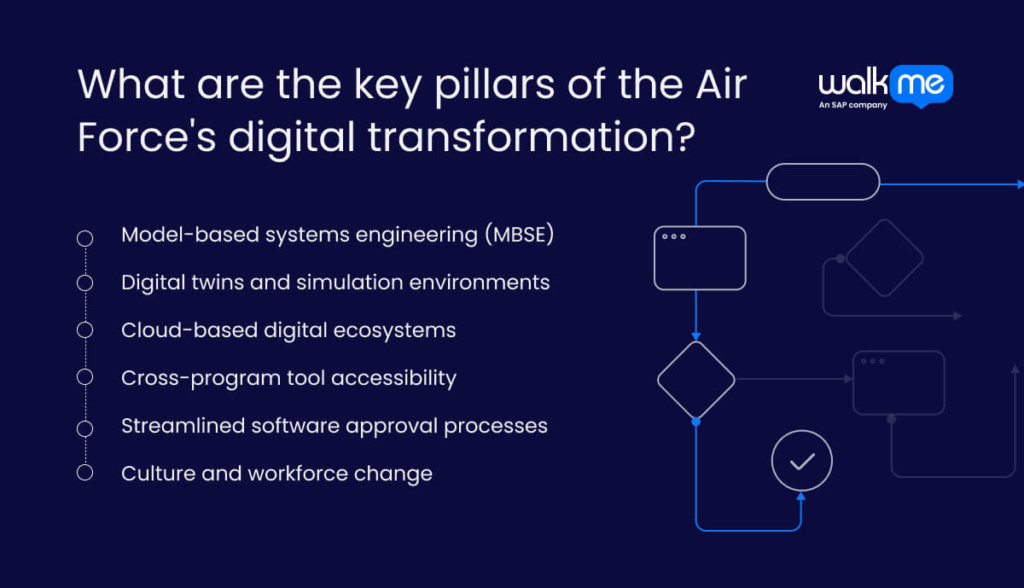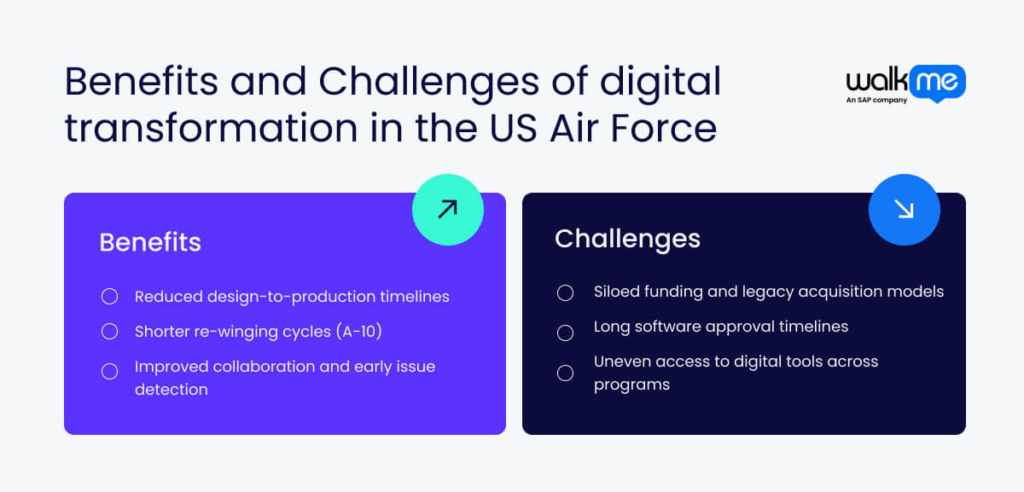The US Air Force has long been under the scrutiny of lawmakers and defense analysts for lagging behind in digital transformation.
But momentum is shifting. Through initiatives like ABMS (Advanced Battle Management System) and the Digital Air Base, the Air Force is pushing AI data management, integration, and agile software development.
Looking ahead, leaders are targeting enterprise cloud expansion, zero-trust architecture, and automation technology as pillars of a faster, more adaptable digital warfighting force.
This article examines how the US Air Force is accelerating its digital transformation to address challenges posed by legacy systems and expedite software delivery. It also encompasses efforts to enhance engineering, foster collaboration, and drive cultural change for a faster, smarter, and more resilient force.
What does digital transformation mean for the Air Force?
The Air Force’s digital transformation is a structured overhaul of legacy systems, processes, and architectures designed to enable faster decision-making, integrated command, and mission resilience at scale.
It replaces static networks with dynamic, software-defined infrastructure, moving away from manual workflows toward autonomous, data-driven operations. This includes deploying DevSecOps pipelines for continuous software delivery, integrating open architectures for joint-domain interoperability, and applying edge computing in contested environments.
Unlike routine IT upgrades, it’s a doctrinal shift and involves treating data as a weapon system and software as a combat capability.
Programs like Platform One and EdgeConnect exemplify this pivot toward modular, scalable, and secure digital warfighting readiness.
Why is the Air Force’s digital transformation important?
Air Force digital transformation matters because modern warfare moves at breakneck speed.
According to the Department of the Air Force’s Digital Transformation Office, “Regardless of the domain, digital transformation is the disruptive enabler the DAF needs to maintain its competitive edge.” This highlights the Air Force’s commitment to leveraging digital processes to stay ahead in modern warfare.
Pilots, commanders, and analysts can’t afford delays caused by obsolete systems or siloed data. When all you have are seconds to decide, having the right information instantly can mean the difference between success and failure.
Digital tools enable the Air Force to connect aircraft, sensors, and operations in real-time. That means faster targeting, smarter logistics, and better protection for warfighters.
Think of modern Air Force digital transformation as a continuous push to embed new technologies that make the force faster, smarter, and more adaptable—able to out-think adversaries and stay mission-ready in a connected, contested battlespace.
What are the key pillars of the Air Force’s digital transformation?

Now that you understand digital transformation in the US Air Force, it’s time to examine the key pillars.
For any government digital transformation to succeed, it must be understood deeply across every level, ensuring that technology, culture, and processes align with mission goals and drive lasting change.
Let’s take a look at the key pillars of digital transformation in the US Air Force:
Model-based systems engineering (MBSE)
MBSE uses digital models instead of traditional paper-oriented designs to build its systems. The Air Force applies this to projects like the B-21 bomber, letting engineers work together in real time. It shifts engineering from static documents to living digital blueprints, cutting errors and speeding up construction by keeping designs current and easy to update throughout the process.
Digital twins and simulation environments
Digital twins are virtual copies of real equipment, like an F-35 jet. The Air Force uses these to test and predict problems without risking actual planes or people. It helps fix issues early and plan missions better, saving time and money.
Cloud-based digital ecosystems
Cloud technology connects Air Force teams by sharing data and tools online securely. Platforms like the Air Force’s Enterprise Cloud allow people from different places to work together, speeding up decisions and helping fight threats faster. This logical access to information ensures everyone stays aligned, even in fast-moving or complex operations.
Cross-program tool accessibility
The Air Force promotes software collaboration through centralized tool access, breaking down barriers between units. For instance, the Kessel Run team uses shared platforms to develop and deploy applications rapidly across different missions. This standardization prevents duplicated work, allowing faster integration of updates and improving mission readiness across multiple programs.
Streamlined software approval processes
Software approval processes have been revamped to allow updates in weeks rather than years. For example, the Continuous Authorization to Operate (cATO) process enables software teams to deploy updates rapidly while maintaining strict security checks. This ongoing integrated risk management speeds improvements, keeping systems both safe and mission-ready.
Culture and workforce change
Technology evolves fast, and so must the people behind it. The Air Force invests in reskilling and upskilling its workforce, focusing on AI, cloud computing, and agile practices. Initiatives like Digital University equip personnel with hands-on training, empowering them to embrace innovation and respond swiftly to emerging challenges. In these instances, adapting the culture is as vital as adopting new tools.
What strategies help scale digital transformation across the Air Force?
As mentioned, digital transformation is an ongoing process, and scaling projects within the US Air Force is tricky and resource-intensive.
The key here is to think outside the box and approach scaling as a coordinated, cross-functional team effort. When teams are aligned and strategies connected, progress happens faster, redundancies shrink, and digital adoption solutions can be deployed without losing momentum.
With that in mind, let’s take a closer look at some strategies that help scale digital transformation across the US Air Force:
Break down silos between program offices
When program offices operate in isolation, progress slows and transformation efforts stall. The Air Force is starting to connect teams earlier, during planning, not just after delivery. For instance, when a sustainment unit feeds real-time field data to a design team, updates happen swiftly, and fewer mistakes occur.
This shift creates a higher sense of momentum. Instead of waiting for feedback loops, programs learn from each other as they go. It saves time, avoids waste, and helps build smarter systems.
Fund and democratize tool access
The Air Force is moving toward unit-wide access, removing bottlenecks created by license limits or approval layers. A logistics team at one base recently shifted from requesting data analysis help to doing it themselves using shared tools.
It changed how they worked and enabled them to be faster, more confident, and better aligned. Giving people access means giving them agency, meaning that when everyone can contribute directly, teams get more promising outcomes with fewer delays.
Create shared infrastructure for acquisition
Instead of letting every program draft its own playbook, Air Force leadership is rolling out shared onboarding and acculturation frameworks with templates that fit, workflows already vetted, and review paths that flow.
A satellite team recently lifted onboarding methods from a cyber unit and shaved months off delivery. Frameworks built for reuse don’t impose limits but are built to clear the runway. With the groundwork set, teams spend energy on what counts, fielding better capability, faster.
Consolidate software approval authorities
Too many approvals can stall progress, especially in government or military-based operations. Instead of layering reviews across multiple offices, decision-making is being centralized. A single point of contact in one test wing cut software delivery time dramatically by removing unnecessary handoffs.
This sharper focus means faster approvals, fewer revisions, and quicker access to new tools. Streamlining oversight doesn’t sacrifice rigor and should always ensure clarity about who drives the process forward.
Drive cultural adoption and training
The Air Force builds trust through low-pressure spaces where experimentation is encouraged, not penalized.
One squadron holds weekly hands-on sessions for testing tools without fear of mistakes. This approach boosts confidence, opens honest feedback channels, and turns hesitation into action. True change takes hold only when teams feel empowered to lead it on their own terms.

What are the benefits of digital transformation in the US Air Force?
Under the surface of new tools and systems, transformation changes how the Air Force thinks and operates. Knowing the benefits shows what’s working and what’s worth investing in.
With that in mind, let’s take a closer look at the benefits of digital transformation:
Reduced design-to-production timelines
Modern digital workflows eliminate delays that once came from paper-based plans and siloed tools. Designers, engineers, and manufacturers now work from a shared digital thread. This alignment reduces handoff errors and rework, allowing production to begin sooner. It also accelerates the delivery of mission-ready systems without sacrificing precision or oversight.
Shorter re-winging cycles (A-10)
The A-10’s digital re-winging effort proved that transformation isn’t hypothetical. Replacing legacy documentation with updated digital models helped teams reduce the time needed to plan, validate, and execute repairs. This vastly streamlined approach preserves aircraft readiness and demonstrates what’s possible when modernization is applied to aging platforms.
Improved collaboration and early issue detection
Working from connected platforms enables dispersed teams to identify mismatches, gaps, or technical conflicts earlier in the development process. This proactive visibility lowers the cost of changes and reduces the risk of late-stage surprises. Teams can solve problems in real time before they become bottlenecks.
What are the challenges of digital transformation in the US Air Force?
Scaling digital transformation in the Air Force doesn’t happen in a vacuum. It’s shaped by legacy systems, operational demands, and the need to move quickly without losing precision or trust.
Understanding what stands in the way helps clarify what real progress looks like and the lengths we’ll go to get there.
Let’s take a closer look at the challenges of digital transformation in the US Air Force:
Siloed funding and legacy acquisition models
Programs struggle to coordinate or reuse resources when funding streams and acquisition practices stay tied to old structures. Instead of scaling what works, teams often duplicate effort. Transformation requires more flexible models that support collaboration across Air Force offices, not just compliance within them.
Long software approval timelines
Security and oversight matter, but even ready-to-deploy software often sits idle when approvals take months to obtain. Critical capabilities often lag behind mission needs. The process must evolve to match modern speeds, with smarter checks that reduce risk without blocking progress.
Uneven access to digital tools across programs
Digital maturity varies widely across the Air Force. Some teams build with modern platforms; others rely on outdated systems. That imbalance can sometimes limit collaboration and slow innovation. Equal access to foundational tools should not be considered a luxury but rather a requirement for force-wide transformation.
What’s next for Air Force digital transformation?
You’ve seen that digital transformation isn’t a one-size-fits-all effort and is never truly finished.
This is especially true for government organizations like the U.S. Air Force, whose mission demands long-term thinking and daily operational excellence.
With constant pressure to deliver value for money to the American public, the Air Force must also serve and protect in real time. When looking ahead, it’s easy to get caught up in emerging innovations like AI and autonomous systems.
But the future of Air Force digital transformation won’t be driven by technology alone. It depends on the mindsets of policy makers and budget holders, as well as those willing to think long-term, invest in what works, and remove the roadblocks standing in the way of lasting change.
FAQs
The “There is No Spoon” document challenges old, slow processes in the Air Force. It encourages teams to adopt new digital tools and reevaluate their work processes. The goal is to speed up innovation and ensure technology helps the Air Force move faster and smarter.
The Digital Acceleration Task Force helps the Air Force adopt digital projects quickly. They remove roadblocks and connect different teams to work better together. Their focus is on speeding up the use of new technology so the Air Force can respond faster to changing needs.
The Digital Transformation Office leads the Air Force’s digital change efforts. It guides how technology updates happen across missions and systems. The DTO ensures digital tools improve operations and help the Air Force stay modern and ready for future challenges.
Digital engineering creates virtual models of systems like Sentinel satellites and T-7 jets. These digital models help engineers design, test, and improve equipment faster and cheaper. They also reduce errors by allowing changes before physical parts are built, speeding up development and cutting costs.
The Air Force is streamlining approval processes and delegating clear decision-making authority to fewer individuals. This enables software updates to occur faster and more smoothly. The process still checks security closely, but it helps new tools reach users quickly, keeping systems up to date.

